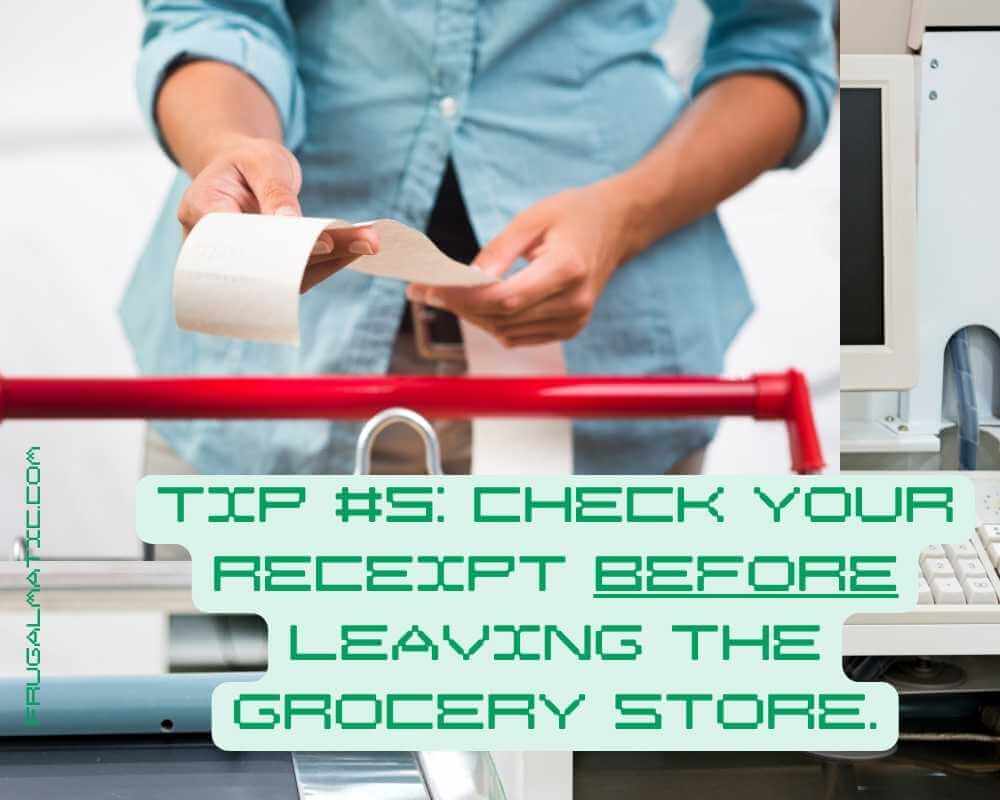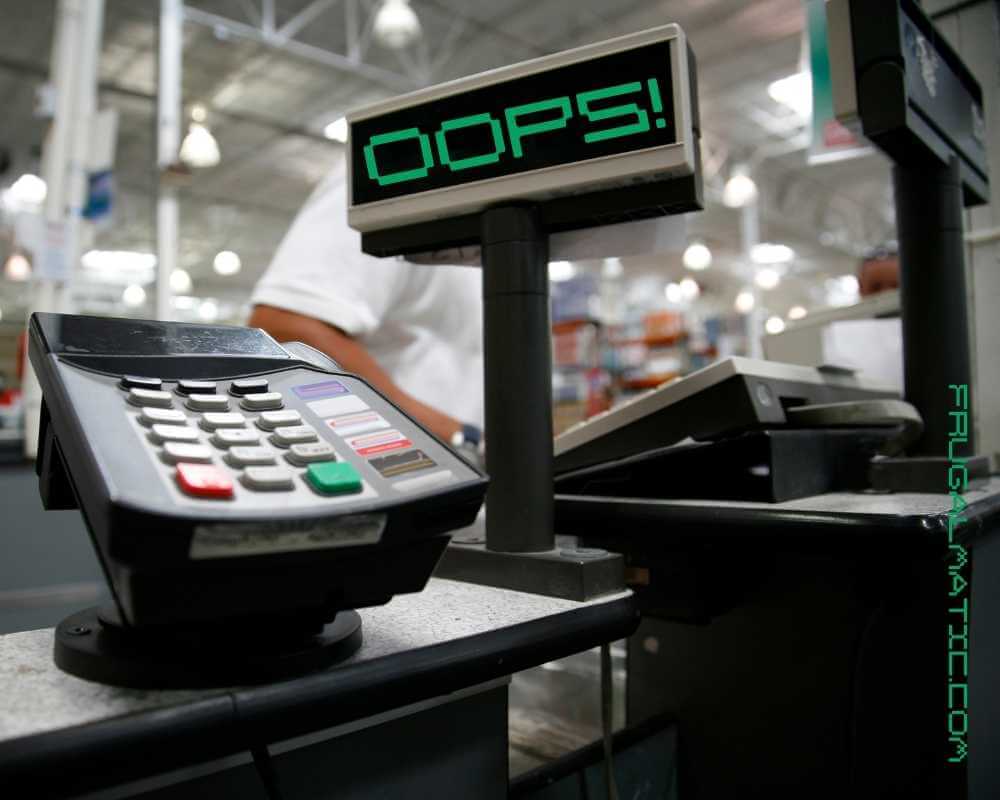This post was last updated on September 8th, 2022 at 08:42 pm
Thanks to high inflation, the internet is full of advice on how to save money at the grocery store. Coupons are popular again, though it’s a mistake to fixate on them. You can easily lose more than these coupons are worth by neglecting to pay close attention to what stores actually charge you at the checkout. They can and do make pricing mistakes. To avoid overpaying for groceries, I’ve developed what I consider “best practices” for grocery shopping.
I won’t identify a particular store because I’ve had similar experiences at many different ones. I will say that I’ve encountered relatively few pricing errors at my favorite grocery store, Aldi. But Aldi isn’t the only place I shop. I shop the best deals, and sometimes they’re found at other stores. Seeing a good deal, however, isn’t the same thing as getting a good deal. Here are my six tips to help you walk out of the grocery store paying only what should pay:
01 If you have a choice, choose the experienced cashier/checker.
While checking out groceries isn’t rocket science, it requires attentiveness. Some checkers seem to “check out” (pun intended) as they scan your groceries. Or, you might get a new checker who’s still learning the difference between lettuce and kale. In my experience, new checkers are also more likely to forget to scan coupons, including ones contained in the store’s own flier. Forgetting to scan coupons can add several dollars to your bill. At their best, experienced checkers will catch pricing problems before they show up on your receipt. Trust your instinct on this and go to the line with a checker who appears to know what they’re doing.
02 Watch the prices as the checker scans your items.
At the checkout, two tasks can distract you from your money-saving mission: loading your groceries onto the counter belts and bagging your groceries. I try to spend as much time as possible watching the checker scan each item and making sure the correct prices appear on the cash register screen.
It’s easier to catch mistakes at this point than spotting them later, after you get your receipt. Pay close attention to produce, in particular. Here’s what I mean: During a recent shopping trip, a checker incorrectly recorded my apples as “Honeycrisp.” I told her, “Excuse me, but those are Braeburn apples.” She looked at them and said: “Oops. You know, all these apples look the same.” I’m not kidding! The price difference was big: $11 versus $5. I would have been overcharged $6 because she didn’t know her apples (or, apparently, that you can look at that little sticker on each apple identifying the type of apple).

03 Pay extra attention to marked-down prices.
I’m a big fan of peeking at the clearance section whenever and wherever I shop. Sometimes I find some amazing deals, such as my recent score of a 5-pound bag of organic flour for 99 cents. Or, my four 99-cent bags of whole-bean coffee. Not to mention last year’s haul of $1 bottles of balsamic vinegar. Unfortunately, I sometimes encounter mistakes at the checkout when checkers handle these marked-down items.
I’ve had some checkers scan clearance items at their regular price, completely ignoring the marked-down price. Often, stores will conceal an item’s barcode to prevent it from being scanned at the regular price—but not always. Sometimes, the checker must “override” the regular price and enter the clearance price.
These multiple steps create room for error, especially for newbie checkers. One time, I bought some granola bars on clearance, and the checker not only charged me the regular price, she added the clearance price to the regular price. So, I would have ended up paying more for this “clearance” item than I would have if I had simply bought it at the regular price. Fortunately, I caught the mistake before paying.
To prevent pricing mix-ups at the checkout, I have my clearance items scanned last. Also, I point them out to the checker so they know to “ring up” the discounted price, not the regular one. I then watch to make sure the proper price is entered.
04 Alert management to discrepancies.
Occasionally, I’ll notice a sale price in a grocery flier doesn’t match up with the in-store price. These discrepancies are probably innocent mistakes, but they’re pet peeves of mine. When they happen, I tell a manager, who almost always agrees to honor the advertised sale price. Sometimes, they’ll do even better. That happened a few weeks ago with a couple boxes of Grape Nuts, a favorite cereal of mine. When I told him the flier showed $3.99 but the shelf price was $4.99, the manager pulled two orange stickers out of a pocket and said I could have both boxes for free. “I wasn’t expecting that,” I said. “But I won’t argue with you.” So I saved $8 just for telling management about the discrepancy. Of course, I don’t always get items for free in these situations, but I sometimes do.
05 Inspect your receipt before leaving the store.
Despite my best intentions to catch errors while at the checkout, some slip by me. After checking out, I inspect my receipt, with my groceries and their prices still fresh in my mind. If I wait until after returning home, I’m likely to forget the details that I need to know to determine whether a mistake was made. For example, during a recent review of my receipt, I noticed I had been overcharged for a carton of eggs that were supposed to be on sale. I brought the receipt to the manager, who agreed and refunded the difference. It was a small amount, but it does add up when you repeatedly catch small mistakes like I do.

06 Shop on weekdays at the start of a sales cycle.
A lot of people shop on the weekends because that’s the only time they can. If you’re able, however, it’s better to shop on weekday afternoons near the start of a sale, typically a Wednesday or Thursday. If you wait until the weekend, stores might have sold out of their best deals. Also, some stores add items to their clearance sections on weekdays, but these markdowns often disappear from the shelves before the weekend arrives.
Finally, I’ve noticed store managers are less busy on weekday afternoons and seem better able to address concerns or complaints. Likewise, because the lines tend to be shorter on weekdays, checkers seem less stressed and, thus, less prone to making mistakes.
Read my ‘How to fight inflation’ series
Remember to stay polite
For all the errors I catch and complaining I do, you’d think I’d be a real pain in the butt to employees. Maybe I am, but I make sure to be polite. When you’re scrutinizing your receipts or complaining to management about being overcharged for groceries, try to remember to smile. I find when I’m polite in expressing my concerns, that’s when a manager is more likely to give me a little extra, like those two boxes of free cereal.
My advice is to expect mistakes and build time into your schedule for correcting them. This way, it’s easier to be patient in dealing with managers, some of whom can get defensive. If leave a store without experiencing a problem, then I’m pleasantly surprised.
Finally, It’s important to be firm and not afraid to correct even small mistakes—if not for the money, then the principle of the matter. And don’t apologize for these stores not doing their job. If your efforts end up holding up the checkout line, so be it. That’s not your fault. It’s the store’s fault. Besides, you’re doing the other customers a favor. You’re catching problems not only for yourself but for them, too.

